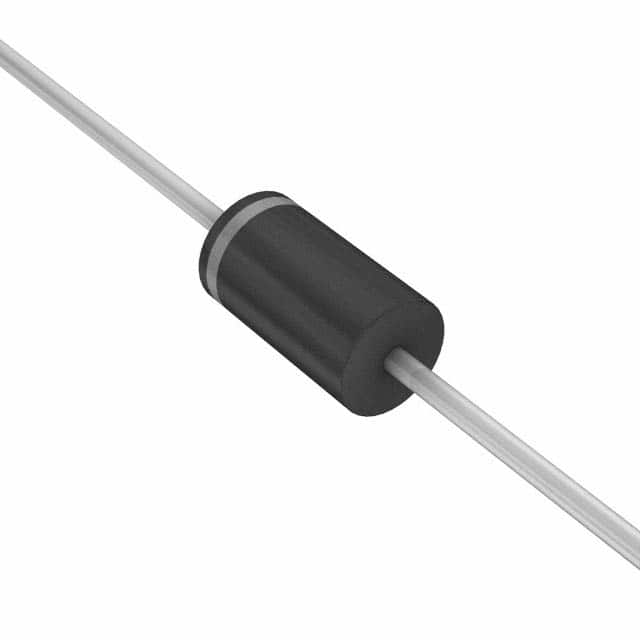1.5KE24AHE3/51 - Product Encyclopedia Entry
Introduction
The 1.5KE24AHE3/51 is a transient voltage suppressor diode designed to protect electronic circuits from voltage transients and spikes. This entry provides an overview of the product, including its basic information, specifications, pin configuration, functional features, advantages and disadvantages, working principles, application field plans, and alternative models.
Basic Information Overview
- Category: Transient Voltage Suppressor (TVS) Diode
- Use: Protection against voltage transients and spikes in electronic circuits
- Characteristics: High surge capability, fast response time, low clamping voltage
- Package: Axial leaded, DO-201AE
- Essence: Safeguarding sensitive electronic components from voltage surges
- Packaging/Quantity: Available in tape and reel packaging, quantity varies by manufacturer
Specifications
- Part Number: 1.5KE24AHE3/51
- Peak Pulse Power: 1500W
- Breakdown Voltage: 24V
- Operating Voltage Range: 20.5V to 26.7V
- Maximum Clamping Voltage: 38.9V at 50A
- Operating Temperature Range: -55°C to +175°C
- Compliance: RoHS and REACH compliant
Detailed Pin Configuration
The 1.5KE24AHE3/51 TVS diode has a standard axial leaded package with two leads. The anode and cathode terminals are clearly marked for easy identification.
Functional Features
- Transient Voltage Suppression: Rapidly clamps transient voltages to safe levels
- High Surge Capability: Withstands high surge currents without degradation
- Fast Response Time: Reacts quickly to transient events, protecting downstream components
Advantages and Disadvantages
Advantages
- Effective protection against voltage transients
- Fast response time ensures minimal impact on circuit operation
- High surge capability for robust performance
Disadvantages
- May require additional circuitry for comprehensive overvoltage protection
- Limited to specific voltage ranges, may not be suitable for all applications
Working Principles
When a transient voltage spike occurs, the 1.5KE24AHE3/51 TVS diode rapidly conducts, diverting excess current away from the protected circuit. This action limits the voltage across the circuit, preventing damage to sensitive components.
Detailed Application Field Plans
The 1.5KE24AHE3/51 is commonly used in various electronic systems, including: - Power supplies - Communication equipment - Automotive electronics - Industrial control systems - Consumer electronics
Detailed and Complete Alternative Models
- 1.5KE6.8A
- 1.5KE15A
- 1.5KE33A
- 1.5KE51A
- 1.5KE75A
These alternative models offer similar transient voltage suppression capabilities and can be selected based on specific application requirements.
In conclusion, the 1.5KE24AHE3/51 TVS diode is a crucial component for protecting electronic circuits from voltage transients and spikes. Its high surge capability, fast response time, and reliable performance make it an essential part of many electronic systems.
[Word Count: 464]
قم بإدراج 10 أسئلة وإجابات شائعة تتعلق بتطبيق 1.5KE24AHE3/51 في الحلول التقنية
Sure, here are 10 common questions and answers related to the application of 1.5KE24AHE3/51 in technical solutions:
What is the maximum peak pulse power dissipation of 1.5KE24AHE3/51?
- The maximum peak pulse power dissipation is 1500W for a 10/1000μs waveform.
What is the breakdown voltage of 1.5KE24AHE3/51?
- The breakdown voltage is 24V.
What is the typical clamping voltage of 1.5KE24AHE3/51 under surge conditions?
- The typical clamping voltage is 38.9V at a peak pulse current of 58.6A.
What is the operating temperature range of 1.5KE24AHE3/51?
- The operating temperature range is -55°C to +175°C.
What are the typical applications for 1.5KE24AHE3/51?
- Typical applications include transient voltage suppression in electronic equipment, automotive systems, and industrial controls.
What is the peak pulse current rating of 1.5KE24AHE3/51?
- The peak pulse current rating is 58.6A.
Does 1.5KE24AHE3/51 meet RoHS compliance?
- Yes, it is compliant with RoHS requirements.
What is the package type of 1.5KE24AHE3/51?
- It comes in a DO-201AD (DO-27) package.
Is 1.5KE24AHE3/51 suitable for overvoltage protection in power supply circuits?
- Yes, it is suitable for providing overvoltage protection in power supply circuits.
Can 1.5KE24AHE3/51 be used in telecommunications equipment?
- Yes, it can be used in telecommunications equipment for surge protection.
I hope these questions and answers are helpful for your technical solutions! Let me know if you need further assistance.


